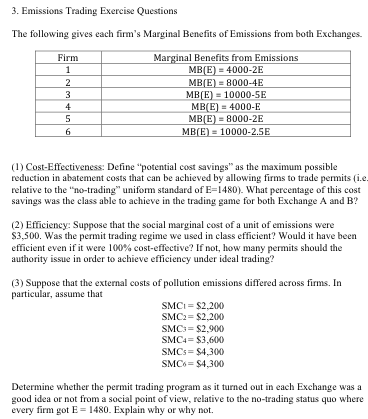
Emissions Trading Exercise Questions The following gives each firm's Marginal Benefits of Emissions from both Exchanges. (1) Cost-Effectiveness: Define "potential cost savings" as the maximum possible. reduction in abatement costs that can be achieved by allowing firms to trade permits (i.e. relative to the "no-trading" uniform standard of E=1480). What percentage of this cost savings was the class able to achieve in the Hiding game for both Exchange A and B? (2) Efficiency: Suppose that the social marginal cost of a unit of emissions were $3.500. Was the permit trading regime we used in class efficient? Would it have been efficient even if it were 100% cost-effective? If not, how many permits should the authority issue in order to achieve efficiency under ideal trading? (3) Suppose that the external costs of pollution emissions differed across firms. In particular, assume that SMC_1 = $2,200 SMC_2 = $2,200 SMC_3 = $2,900 SMC_4 = $3,600 SMC_5 = $4,300 SMC_6 = $4,300 Determine whether the permit trading program as it turned out in each Exchange was a good idea or not from a social point of view, relative to the no-trading status quo where every firm got E = 1480. Explain why or why not. Emissions Trading Exercise Questions The following gives each firm's Marginal Benefits of Emissions from both Exchanges. (1) Cost-Effectiveness: Define "potential cost savings" as the maximum possible. reduction in abatement costs that can be achieved by allowing firms to trade permits (i.e. relative to the "no-trading" uniform standard of E=1480). What percentage of this cost savings was the class able to achieve in the Hiding game for both Exchange A and B? (2) Efficiency: Suppose that the social marginal cost of a unit of emissions were $3.500. Was the permit trading regime we used in class efficient? Would it have been efficient even if it were 100% cost-effective? If not, how many permits should the authority issue in order to achieve efficiency under ideal trading? (3) Suppose that the external costs of pollution emissions differed across firms. In particular, assume that SMC_1 = $2,200 SMC_2 = $2,200 SMC_3 = $2,900 SMC_4 = $3,600 SMC_5 = $4,300 SMC_6 = $4,300 Determine whether the permit trading program as it turned out in each Exchange was a good idea or not from a social point of view, relative to the no-trading status quo where every firm got E = 1480. Explain why or why not







